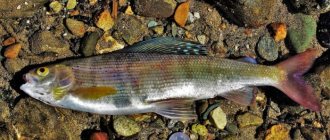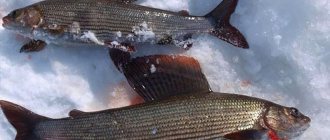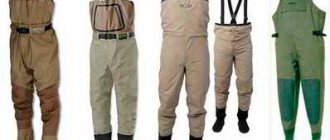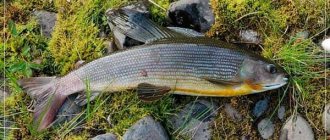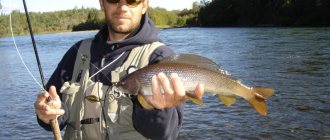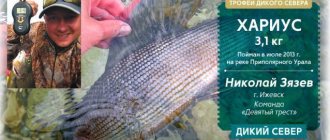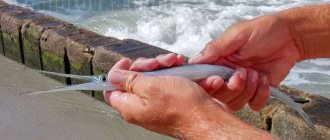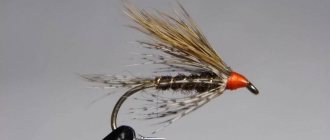Such a fish as grayling is found in many countries of the world; it is also present in Russia in the Siberian and Ural rivers. Trout and salmon are considered close relatives of this inhabitant of the deep, so fly fishing for grayling will bring a lot of pleasure to the fisherman. The term fly fishing itself means hunting for fish using artificial bait, in our case flies. In the article we will describe the manufacturing options and composition of gear, bait, choice of location and tactics for catching grayling.
Types and composition of gear
The following equipment options are suitable for hunting the fish described:
- Fly fishing in the classic version is a tackle that consists of a rod, a special cord and a reel. When using such equipment, the fisherman must be able to make correct casts, play with bait and catch the fish he encounters.
- When using the second option of gear, fishing is carried out using a wire rod with large rings and an inertia-free rod. The drum of such a reel should rotate easily. A weight is attached to the main fishing line with a cross-section of 0.2...0.3 millimeters, which is used to cast the fly to the required distance.
- Another tackle for grayling is a boat or torpedo. This element is made of lightweight materials, and one or more baits are tied to it. Here you need to choose a rigid rod with an inertia-free reel, the diameter of the main line is from 0.3 to 0.4 millimeters.
More life
To make the nymph's play more lively and thus more seductive, you can raise the rod from time to time or select the line a little faster.
In any case, it is necessary to maintain constant direct contact with the nymph, so the line after burying the fly should be as straight as possible in order to immediately respond to a bite. Keep the rod at approximately right angles to the line at all times. If a hard bite unexpectedly occurs, you can always dampen its power a little with a fishing rod. When the rod is extended in the direction of the line and the nymph, the leash will break off in the event of a powerful bite even before you can react. Hooking is done either with a short jerk of the rod, or with a strong pull of the hand, selecting the line. If you hook a strong fish, quickly wind the tightened line around the reel, keeping the fish taut. After that, you can fish it out using a reel. This way you will avoid the cord getting tangled in coastal vegetation or in the landing net. Share with your friends!
Types and selection of flies
Throughout the season, grayling takes swimming insects well; most often it is caught using floating, dry flies. This bait can have different shapes and colors.
Photo 2. Flies for every taste.
Note! Grayling will be attracted to a fly that imitates a natural insect found in a particular area. In this regard, the bait should be selected according to the food supply of the fish in question.
You shouldn’t limit yourself to dry flies; wet models can also attract the attention of a predator. Such products resemble small underwater inhabitants of rivers, which grayling loves to feast on. It is advisable to use such baits in cold or wet weather, because under such climatic conditions insects almost never appear above the surface of the river.
For dry flies, we can recommend the following models:
- "Cdc - dun";
- "Parachute Adams";
- "Klinkhammer"
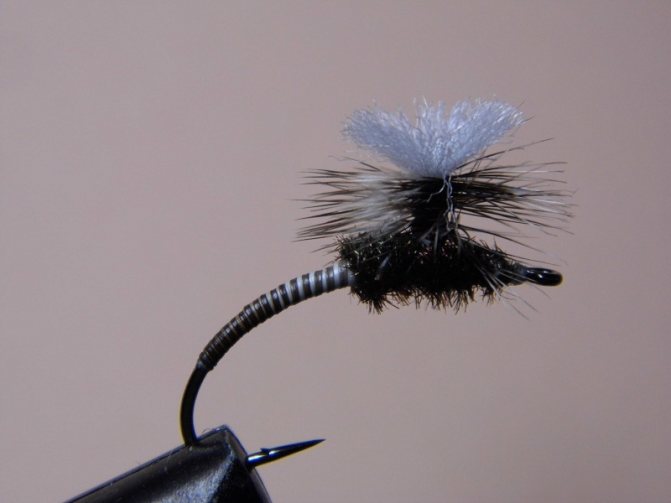
Photo 3. The famous “Klinkhammer”.
Popular wet flies:
- "Red tag";
- "Hasenohr";
- "Blue dun"
Many fishermen know that in turbid water the fish in question respond well to pink and yellow baits. An irregularly shaped fly with elongated wings or legs will only scare off a predator. It is advisable to use miniature flies, since fish take large baits extremely reluctantly.
The process of catching grayling with flies
Fishing for grayling with flies is divided by anglers into the following components:
- Let's throw it away. You need to “shoot” the fly a little further than the potential fish locations. The bait is supplied in the direction of the current or by moving it to the place where the “hunter” is located.
- We move the bait. The fisherman holds, pulls, presses the line, performs maneuvers with the rod, raising or lowering it.
- We hook and fish out. Noticing the bite, the fisherman begins to hook and fish. You should try to avoid places where there may be underwater snags.
Video on catching grayling with flies
Where and when to catch grayling
Experienced fishermen claim that grayling begins to be caught in the spring, after the water clears and the river drops to the standard level. Until this time, the females will have time to lay eggs, get sick and begin to actively feed. The hunger of predators can last for several days, then weakens. This fish is caught by fly fishing from late spring until autumn, but to get a good catch, the fisherman must use certain tactics and bait.
A good bite is observed in the autumn, at which time the predator actively consumes food to accumulate fat. Insects fly little at this time, so it is better to catch grayling using sinking flies that resemble a halo. Morning or evening fishing is considered especially effective; at this time of day, the inhabitant of the depths stands in snags or holes. The predator prefers places with high oxygen concentrations and clean water. His attention can be attracted by suitable bait and correct wiring.
How to choose a place for fly fishing for grayling
They begin to catch grayling in the spring, when the water drops to standard levels. By this time, spawning ends and a good bite begins. The duration of the zhor can be from a couple of days to a week. It is better to choose shallow streams with strong currents, close to the shore. Closer to summer, especially large individuals can be found in holes where there is a weak current.
The most important thing is to cast correctly so that the bait falls smoothly. If the bait is in a good place, you should expect a sharp capture. When casting, it is very important that the fly hits the water before the line, otherwise the fish may get scared. For a small river, you can use short rods - no more than 2.5 meters; for a wide reservoir, a length of 3 meters will do - this is enough for long casting.
WINTER FLY FISHING IN SIGHT – GRAYLING
South wind. Remains of dirty snow. A chained armada of leaden clouds with rare intervals the color of powdered baby food disappears into the greedy well of the horizon. The invisible hole absorbs and consumes lumps of aleurone matter, saturated and ready to rain crystallized legions of water droplets onto the hallowed grayling shores. There is a shadow of scandal in the air - the shade is at least plus six, it smells like fish. The inversion attack of rising air currents and the proctological boredom of a fly fisherman collided - expect trouble...
I'm surprised at my own audacity. I'm rummaging through my backpack. I courageously restrain the withering glances of my family, who have long been reassured and convinced in my soul: the fly fishing season, as such, has disappeared with the last willow leaf and the word of oath. Not expecting an insidious trick, the relatives smiled sweetly and looked condescendingly at the fun of sculpting flies... Alarm! A violator of the convention and, in addition, a malicious separatist, the sin is not only knitting, but also going fishing! It is necessary, and he also has the courage to assert: with the first frosts, the process of material embodiment of fly fishing desire and the art of catching grayling opens. In the roomy interior of the backpack, along with a camera and neoprene pants, a vest, jacket, gloves and, just in case, a bottle of beer accompanied by a lush liver pate sandwich disappear. There was a free nook left for the thermos, and at the same time it could hold a two-liter bottle of mineral water. Why so much liquid? We know the service, guys, goodbye dear ones, it will be difficult and hot there... The wife, like an infirmary nurse, reluctantly and shedding tears, takes care of a hopelessly ill patient with the hope of a miracle of home comfort and mechanically adds coffee. The son, cut off from the virtual world, watches indifferently: “Yes, children will not cry at your grave and there will be no cherished thing - “Daddy, daddy, can you hear us?” then he begins to talk about some distant relative who lost his estate at cards, got drunk and, besides the damned bitter, in addition to everything else, “disappeared” while fishing... Pressed down by the atmosphere, I feel like I’m poorly sculpted by nature, but I don’t give in to provocations and Methodically, without looking back, I load up on the road.
The reason for visiting the grayling river in winter was not a walking mood with a keen desire to see the historical places of summer “military glory” or even a vile thought to sneak away from family and children... The blame for everything, I already repented, was the air temperature. What has been happening with the weather in recent years is extremely serious. Fact: with the trend towards rising temperatures and due to natural resistance, we will soon move on to growing carp on the original salmon spawning grounds, or we will begin to oscillate between two principles - continue to plant potatoes or start planting pineapple crops... There are no words, this is worrying: the expansion of ozone holes, the melting of glaciers, - and sometimes it’s terribly scary - shaking of the earth’s crust in neighboring Mexico. As the great Hugo said: “Stubbornness of mind is stupidity combined with stupidity and serving as its complement”... Extend the season, despite significant losses in relationships with loved ones. For what? Well, the Frenchman was not friendly with fly fishing, that’s for sure... I didn’t know and didn’t guess that there was a calculus of a different order in this world, with quiet happiness on a winter river, in an embrace with a deceptively asleep nature, hidden fish pools and fantastic melodies of an elastic cord. Having shown the will to win, having weighed all the pros and cons, we are invariably convinced that winter fly fishing is a medicine, proven by its anti-stress effect on stringy household items and bringing the demise of the stagnant off-season closer. And stubbornness is a tribute to passion.
At the instigation of Konstantin Kuzmin, a spinning virtuoso, fishing with a jig-throwing tool at sub-zero temperatures has taken the form of a craze. Vlad Novikov’s unique experiments with underground spinning technology and his great positioning system brought confusion and a historical turning point in the consciousness of all fishing humanity. Winter fly fishing will tread a path, I’m sure, if we don’t start comparing the technical capabilities of spinning casting with a thin fishing line and a stiff fly line, in vain attempts to make its way among the frozen rings of a high-modulus stick. We always need a plus. Part and whole. "Black Code" of winter time. I, almost a conservative, don’t understand at all how some winter spinning enthusiasts manage to fish at temperatures below minus 15° C. That’s where the real “sick people” are! I tip my hat to them!
Well, well, let’s move on to the third shift and first we’ll deal with the wintering of European grayling. Unlike the Siberian brother, the European one does not have a clear tendency to slide into large rivers when it gets cold; it can remain in small non-freezing reservoirs. However, it always chooses deep places with a relatively calm current and a favorite soil consisting of medium pebbles. It is possible to park on sandy slopes or on a riffle drainage stream, when there are “breakwaters” at the bottom - something like decent stones or alternating holes. On especially warm and sunny winter days, you can detect the appearance of the “gray cardinal” at typical summer sites - on a calming stream after a roll - and even notice its emergence behind the smallest dry fly. At first glance, the combination “winter - dry fly” sounds, to put it mildly, strange, but entomologists have long established: even in January-February, some species of insects are active and continue to reproduce. Naturally, everything happens at an extremely fast pace, and the peak of the appearance of flies above the surface of the water occurs at the warmest time of the day, around 12-14 hours. A good bait for grayling now is dry Red Tag, with a gray brush, on a hook No. 20-22. In addition to presenting dry imitations, you can try presenting the grayling with a wet fly or a light nymph floated on a floating line just under the film of water. One of the features of winter grayling fishing is this positive detail: the fish, as usual, cluster according to age and from one place you can catch five, or even more, individuals of the same caliber. Therefore, the place where there was at least one bite must be carefully probed for the presence of a whole flock. In summer or autumn, grayling groups consist of small platoons, scattered by fate. The so-called “Royal Guard”, i.e. fighters of the invisible deep-sea front, with a height of 40 cm or more, are generally distinguished by extreme asceticism and prefer solitude. Only in winter will you find the whole team in full force. If you're lucky, the hole with the fish is located - there is a great chance to break your personal record in size and especially in the number of tails. Of course, there is no point in being greedy with the conveyor belt mining method. After a short photo shoot, with a gentlemanly gesture, carefully return the excess fish. The action of fishing on sensitive and therefore gentle tackle will not harm the health of grayling. By the way, the most barbaric attitude towards fish is observed when, even fulfilling the noblest intention of releasing it, they drag it ashore and there it hits the rocks or becomes like a piece of meat breaded with sand. Humanely means not taking the fish out of the water, but gently removing it from the hook.
It’s out of place, but I have to speak out - I consider underwater hunters to be the most notorious poachers of rivers, besides individual gingerbread fish hunting with an electric fishing rod. Accordingly, I am an ardent opponent of the so-called meat shop, which hides its production activities under the sonorous sign of the supposedly sports cooperative “Spearfishing”. What was miraculously not strangled by chemical plants and collective farms, what was not strangled by hydraulic dams, what was not drained by an electrician and not entangled in Chinese fishing nets - everything else alive is knocked out by the dive. How long will we be tolerant observers and passively monitor the process of total destruction of small rivers? The very fact of freshwater hunting LEGALIZED in Russia causes surprise and bewilderment. However, the problem of “pinnipeds” is worthy of a separate publication, and you will certainly see it in the next issues of the newspaper, but for now let’s return to fly fishing...
...For winter grayling baits, choose small flies. To simply say “small” is to say nothing. The very, very “mini-collection” in the category from hook N#18 to N#24 is a must. Among the colors, preference is given to green and rusty brown. I would especially like to note one nymph, which is very easy to make even for the most basic beginner. No special materials are required in its manufacture either. A thin copper wire, a thorax of any soft gray undercoat, is wrapped around the hook No. 18-20, turn to turn. A brush made of hard feathers is undesirable, as the sinking quality of the bait deteriorates, so you can mix a couple of segments of a CDC feather or any down feather into the undercoat. The nymph is simple, but very catchy.
You can figure out the leashes using the following system: a fishing line with a diameter of 0.10 mm is suitable for the size of the fly N№18, all the rest, including N№24, should be tied at 0.08 mm.
Undergrowth made from pieces of monofilament. Classic length 300cm – 0.35mm/100cm, 0.25mm/50cm, 0.20mm/50cm, 0.16mm/50cm, 0.12mm/50cm plus leash (40-60cm).
Cords are a matter of taste, I personally use a floating double cone from Cortland and am satisfied. The floating line is enough for any occasion: by casting upstream, you can submerge lightly weighted nymphs about a meter, and that’s enough for him. Even in winter, grayling is not lazy to rise and takes the fly at mid-water or right next to the film. One of the other features of grayling is the ability to provoke its grip by the number of retrieves, i.e. in a promising place, it is justified to move the fly five to ten times in the same place. It also happens that it takes about a hundred casts to take fish from the heel hole.
Fly fishing people, good luck!
Victor DYACHENKO January 1, 2003 at 00:00
Fish does not go dry, fly fishing for grayling
Ferret, grayling - this is how grayling fishing enthusiasts affectionately call this beautiful and playful fish. Initially, fly fishing began with catching fish such as trout, salmon and grayling. Therefore, we can say that fly fishing for grayling is a classic.
Grayling is not such a rare fish. It is found in the north of the country, in Siberia, in the Urals in central Russia, and, of course, “over the hill” - in the Scandinavian countries, America, Canada, etc. Grayling loves open water and does not recognize shelter. Most often it walks on a stream of water, as well as in places where a fast current is adjacent to a medium one. Prefers pebble or rocky bottom.
Grayling
Dependence of fishing on the time of year
His gastronomic preferences directly depend on the state of the insects at this time of year. He can bite both wet and dry flies. This fish is curious, so it comes across fancy flies.
In ice-free rivers, fly fishing for grayling is carried out all year round. But, in most of the country, fishing begins in early spring, when the water subsides and the rivers return to their channels. At this time, the current baits are wet flies and streamers.
After spawning, the zhor begins, which can last only one day. And if you get there, then you are guaranteed an unforgettable fishing experience.
In the summer heat, the bite gradually subsides, and with the autumn cooling it comes back to life. Autumn is the best time to catch grayling.
Watch the video of how fly fishing happens:
Optimal choice of gear
Since the baits used for fly fishing are small for this fish, the gear will be in the range of class 3-5. Class 6-7 line and rod are selected only for certain heavy flies, for example, Czech nymph.
To catch grayling with a dry fly, floating lines are usually used. If you are fishing with a wet fly, then choose a floating fly line with a sinking end. Your success will depend on how smoothly you can place your fly on the water.
If you are wiring against or across the current, it should be very slow. In the case when the bait is fed with the current, there is no wiring as such, the fly is simply carried away by the water.
Front sights
When there is a massive emergence of insects, it’s time to catch grayling with a dry fly. Your powers of observation will help here. Look around and see which insects are most noticeable. This is exactly what your artificial fly should replicate. But it is impossible to say with 100% certainty that a certain front sight will be suitable in a given period. Grayling decides what he likes, so choosing bait is the most important thing.
To see the flying fly, the grayling jumps out of the water. There are days when the fish are not so active, then fishing is done with nymphs or heavy flies.
Dry
When choosing dry flies, the length and thickness of the “wings” above the water plays a huge role. The silhouette that is visible to grayling depends on this. Since water refracts light, the fish gets a different picture; the water mirror visually enlarges the fly. Therefore, sometimes the front sight needs to be worked on, the excess fluff needs to be trimmed. The silhouette is more important than the color scheme.
Caddisfly - Gangsta caddis
Remembering that grayling lives in fast currents, the fly must be stable. After all, the fish has only a few seconds to examine the bait, and in this short time it should like the silhouette.
In slow currents, the time period for bait recognition increases. In this case, the front sight should imitate its prototype as accurately as possible and be realistic.
In summer and autumn, dry flies will be less relevant. Wet flies and nymphs are favorites during these months. The color of the nymph determines the level of water transparency. In muddy water, flies of bright colors are in demand; more noticeable ones are orange, pink, and black. In clear water the color of the flies will be calmer.
Wet
Wet flies are prototypes of pupae and nymphs that float to the surface. To attract fish, they must be mobile in the water. For example, a nymph that resembles an ugly dragonfly. Moves well in water and is used in the fall.
Nymph dragonfly
Caught - release
After catching this wonderful fish, many try to release it. But this must be done very carefully. If you remove the grayling from the single hook without removing it from the water, then it will not receive major injuries. Of course, if you remove it from the tee (when fishing with a spinning rod), then this fish will not survive, since it cannot be out of the water.
Folk sign: If grasshoppers appear after a flood, it means it’s time to catch grayling.
kakulov.ru
